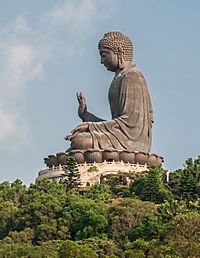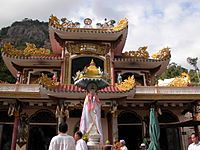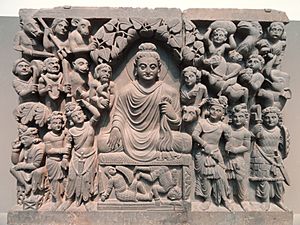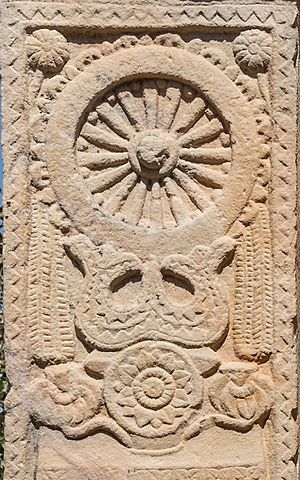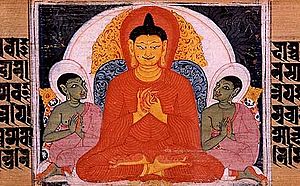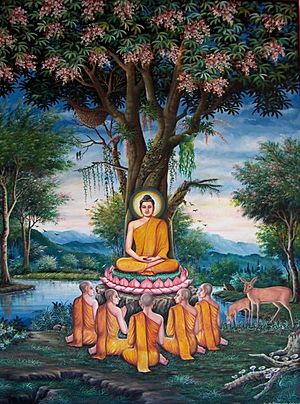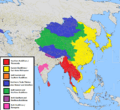Buddhism facts for kids
Buddhism is a way of life and a philosophy that started in India. It is based on the teachings of Siddhartha Gautama, who lived a very long time ago. A Buddha is someone who has 'woken up' to the truth about life. The word 'Buddha' means "the awakened one." Buddhists believe there were many Buddhas before him and will be many more after him.
Over hundreds of years, Gautama Buddha's teachings spread across Asia and eventually to Europe and the Americas. Today, about seven out of every 100 people in the world are Buddhist. There are different types of Buddhism, like Theravada and Mahayana, but they all share similar main ideas.
Many people see Buddhism as a religion, while others see it as a way of thinking or a path to understanding reality.
Contents
The Story of Buddha and His Ideas
Who Was Siddhartha Gautama?
Siddhartha Gautama was born a prince in what is now Nepal around 563 BC. When he grew up, he left his rich life to search for deeper truths. For 45 years, he traveled and taught people in northern India. He passed away when he was 80 years old.
Understanding Suffering
The Buddha taught a lot about how to stop suffering. He saw that all living things experience pain or unhappiness. He believed that if people could overcome this suffering, they would find true happiness.
He taught important ideas like the Four Noble Truths and the Noble Eightfold Path. These teachings help people understand why we suffer and how to stop it. The Buddha also said there are three marks of existence:
- Life is impermanent: Everything changes all the time.
- Life is unsatisfactory: If we are left alone, we are never truly happy.
- Life is interdependent: Everything is connected to everything else.
The Buddha also talked about "three poisons" that cause suffering: desire, anger, and not understanding. He showed that we can end our suffering by letting go of desires and by overcoming anger and not understanding.
Nirvana and the Middle Way
When someone completely lets go of negative feelings and influences, it is called Nirvana. This word means "to extinguish," like putting out a candle flame. This end of suffering is also called Enlightenment. In Buddhism, Nirvana and Enlightenment often mean the same thing.
The Buddha taught that living a balanced life is the best way. He called this "the middle way." He also suggested meditation as a way to train the mind to see the world clearly.
Karma and Reincarnation
The Buddha taught that our actions have consequences, whether good or bad. This idea is called karma. People who make good choices will be happier and have more peace of mind.
Another important Buddhist teaching is reincarnation. This is the idea that when people die, they are reborn as someone or something else. Buddhists try to live their best life in hopes of being reborn into a better situation, until they eventually reach enlightenment.
Buddhists do not focus on whether there is a God or gods. They believe that people should not wait for gods to save them or bring them enlightenment. Instead, they believe each person must work on their own path. Many of the Buddha's ideas are also found in other Indian religions, like Hinduism.
Main Beliefs of Buddhism
The Three Jewels
Buddhists deeply respect and value the Three Jewels. These are:
- The Buddha: Refers to the awakened one, Siddhartha Gautama.
- The Dharma: Refers to the Buddha's teachings.
- The Sangha: Refers to the community of people who follow the Buddha and his teachings.
Buddhists often say, "I take refuge in the Buddha, the Dharma, and the Sangha." They find comfort and guidance in these three treasures.
The Four Noble Truths
The Buddha's first and most important teachings are called the Four Noble Truths. They explain suffering and how to end it:
- Life is suffering: Everyone experiences unhappiness or pain.
- The reason for this suffering is that we want things to be a certain way: Our desires and attachments cause us pain.
- The way to cure suffering is to rise above this desire: By letting go of desires, we can end suffering.
- The way to rise above desire is to follow the Noble Eightfold Path: These are practices that help us change our minds and understanding.
The Noble Eightfold Path
The Buddha taught people to follow a special way of life called the Noble Eightfold Path to understand the Four Noble Truths. These eight steps are:
- Appropriate views: Understand the Four Noble Truths.
- Appropriate thought: Turn your mind towards the Dharma (teachings).
- Appropriate speech: Tell the truth, don't gossip, and don't speak badly about others.
- Appropriate conduct: Don't do bad things like killing, stealing, or living an unclean life.
- Appropriate livelihood: Earn your money in a way that doesn't harm anyone.
- Appropriate effort: Work to make your mind more good and less evil.
- Appropriate mindfulness: Remember the Dharma and use it all the time.
- Appropriate meditation: Practice meditation to understand reality better.
The Five Precepts
Buddhists are encouraged to follow five guidelines, or precepts:
- I will not hurt a person or animal that is alive.
- I will not take something if it was not given to me.
- I will not engage in sexual misconduct.
- I will not lie or say things that hurt people.
- I will not take things that make me lose control or awareness.
If a person wants to be a monk or nun, they will follow even more rules.
Interesting Facts About Buddhism
- The word "Buddhism" was made up by Western scholars in the 1830s. Buddhists don’t usually call their way of life "Buddhism."
- The Buddha started a group of monks and nuns called the Sangha. They have kept his teachings safe for centuries.
- Because it focuses a lot on meditation and mindfulness, some people think of Buddhism more like a type of psychology than a religion.
- In Buddhism, there is no single holy book like in some other religions.
- Buddhists do not believe in a single supreme being or creator God.
- A Buddha is a person who has reached enlightenment.
- Buddhist monks and nuns often shave their hair.
- In Buddhism, each person must work on their own path to enlightenment.
Related pages
Images for kids
-
An image of a lantern used in the Vesak Festival, which celebrates the birth, enlightenment and Parinirvana of Gautama Buddha.
-
The gilded "Emaciated Buddha statue" in an Ubosoth in Bangkok representing the stage of his asceticism
-
Traditional Tibetan Buddhist Thangka depicting the Wheel of Life with its six realms
-
Ramabhar Stupa in Kushinagar, Uttar Pradesh, India is regionally believed to be Buddha's cremation site.
-
An aniconic depiction of the Buddha's spiritual liberation (moksha) or awakening (bodhi), at Sanchi. The Buddha is not depicted, only symbolized by the Bodhi tree and the empty seat.
-
Bodhisattva Maitreya, Gandhara (3rd century), Metropolitan Museum of Art.
-
Buddhist monks collect alms in Si Phan Don, Laos. Giving is a key virtue in Buddhism.
-
Kōdō Sawaki practicing Zazen ("sitting dhyana")
-
Statue of Buddha in Wat Phra Si Rattana Mahathat, Phitsanulok, Thailand
-
Monks debating at Sera Monastery, Tibet
-
A depiction of the supposed First Buddhist council at Rajgir. Communal recitation was one of the original ways of transmitting and preserving Early Buddhist texts.
-
Ajanta Caves, Cave 10, a first period type chaitya worship hall with stupa but no idols.
-
Sanchi Stupa No. 3, near Vidisha, Madhya Pradesh, India.
-
Map of the Buddhist missions during the reign of Ashoka according to the Edicts of Ashoka.
-
A Buddhist triad depicting, left to right, a Kushan, the future buddha Maitreya, Gautama Buddha, the bodhisattva Avalokiteśvara, and a monk. Second–third century. Guimet Museum
-
Site of Nalanda University, a great center of Mahāyāna thought
-
Angkor Thom build by Khmer King Jayavarman VII (c. 1120–1218).
-
Ruins of a temple at the Erdene Zuu Monastery complex in Mongolia.
-
Buryat Buddhist monk in Siberia
-
1893 World Parliament of Religions in Chicago
-
Interior of the Thai Buddhist wat in Nukari, Nurmijärvi, Finland
-
A painting by G. B. Hooijer (c. 1916–1919) reconstructing a scene of Borobudur, the largest Buddhist temple in the world.
-
Frontispiece of the Chinese Diamond Sūtra, the oldest known dated printed book in the world
See also
 In Spanish: Budismo para niños
In Spanish: Budismo para niños



